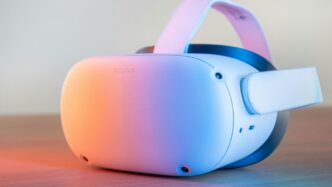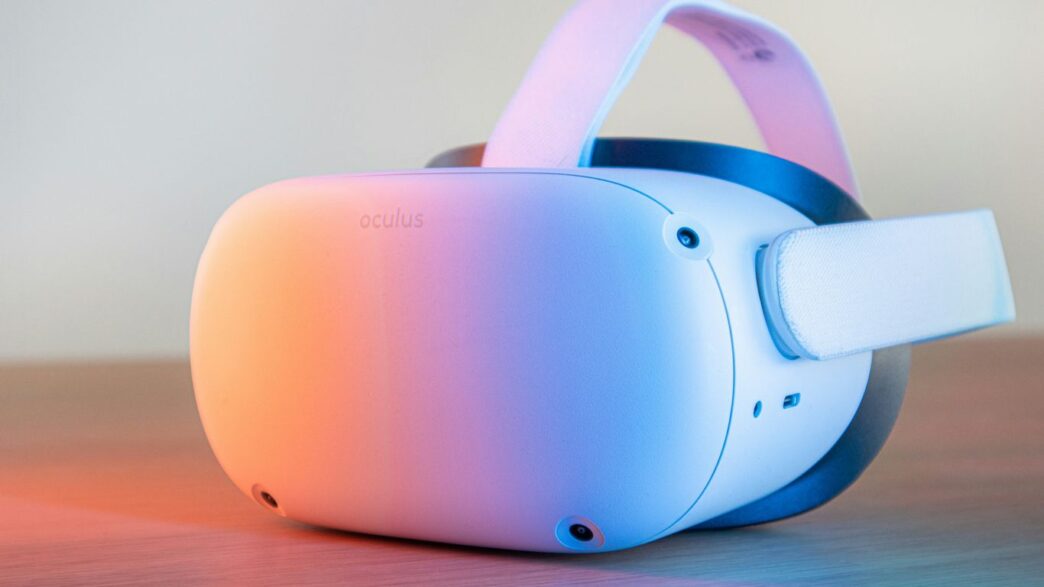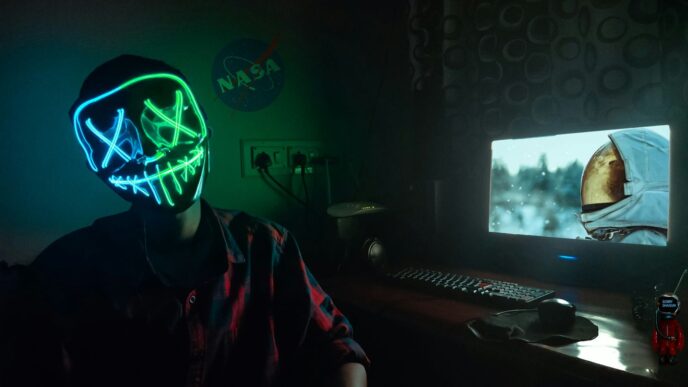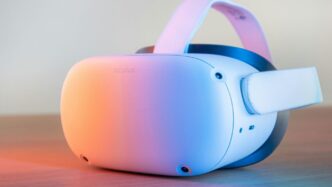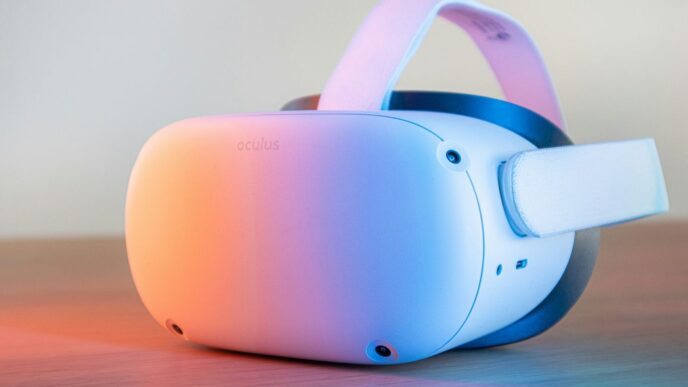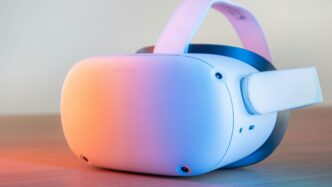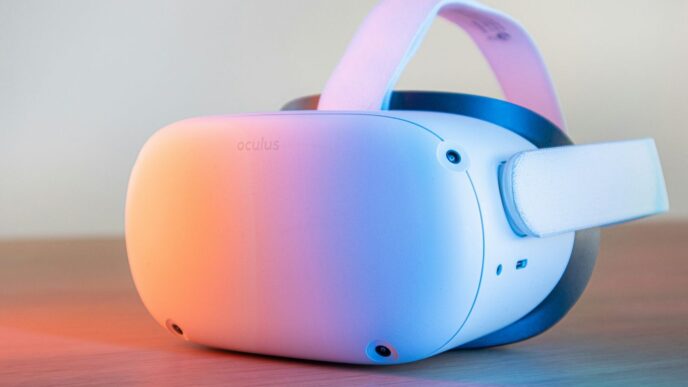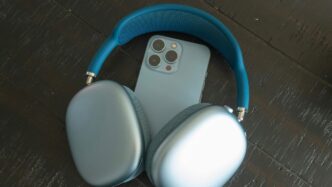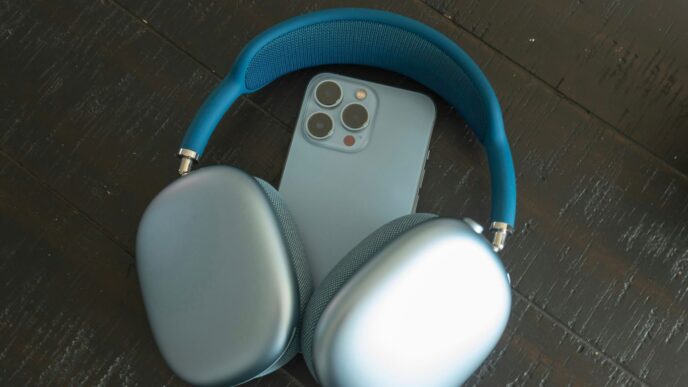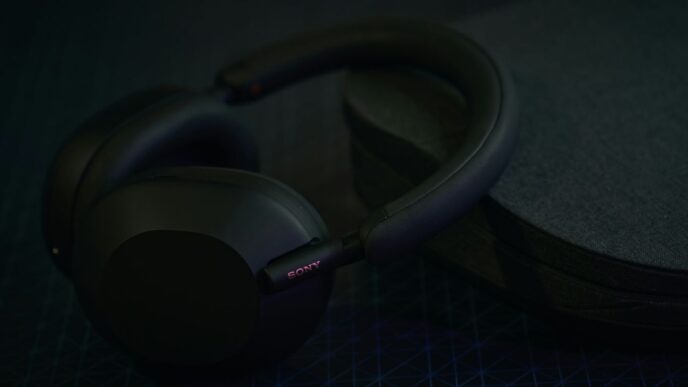Thinking about diving into the world of virtual reality with the Bigscreen Beyond? It’s definitely a unique piece of tech, and a big question on a lot of people’s minds is about the bigscreen beyond price. Is it worth shelling out the cash for this super small, custom-fit headset? Let’s break down what you’re getting, what you’re giving up, and if it makes sense for your VR setup.
Key Takeaways
- The initial bigscreen beyond price is around $1,000, which puts it in the premium category for VR hardware.
- Comfort is a major selling point, with each headset custom-made to the user’s face, but this personalization means it’s not easily shared.
- High-resolution displays offer sharp visuals, but the headset relies on external tracking systems and PC power, adding to the overall cost and setup complexity.
- There are significant trade-offs, such as the lack of built-in audio and the need for a tethered PC connection, which might deter some users.
- The Bigscreen Beyond is best suited for dedicated PC VR enthusiasts who prioritize a lightweight, personalized experience above all else, rather than those looking for a simple, all-in-one solution.
Understanding The Bigscreen Beyond Price Point
Alright, let’s talk about the elephant in the room: the price of the Bigscreen Beyond. It’s not exactly pocket change, is it? This headset lands with a $1,000 price tag, which immediately puts it in a different category than many other VR options out there. It’s a significant investment, and you’ve got to wonder if it’s actually worth it.
The $1,000 VR Headset: Initial Investment
So, you see a $1,000 VR headset, and your first thought might be, ‘Whoa, that’s steep.’ And yeah, it is. Compared to something like a Meta Quest 3, which you can grab for a few hundred bucks, the Bigscreen Beyond is a serious jump. This isn’t a casual purchase for someone just dipping their toes into VR. This price point signals that Bigscreen is aiming for a specific kind of user, one who’s willing to pay a premium for a specialized experience. It’s like comparing a high-end custom-built PC to a pre-built gaming rig you can pick up at a big box store. You’re paying for that bespoke quality and the unique features that come with it.
Considering The Total Cost Of Ownership
But here’s the thing about the $1,000: that’s just the start. To even use the Bigscreen Beyond, you’re going to need a pretty beefy PC. We’re talking a gaming-grade computer that can handle demanding VR applications. If your current rig isn’t up to snuff, you’ll need to factor in the cost of upgrading your PC, which can easily add another grand or more. Then there’s the tracking system. The Bigscreen Beyond relies on SteamVR tracking, which means you’ll need base stations. If you don’t already have them from a previous VR setup, that’s another few hundred dollars. And let’s not forget audio. The headset itself doesn’t have built-in speakers, so you’ll either need to use your own headphones or buy Bigscreen’s upcoming audio strap, which will be an additional cost. So, that initial $1,000 can quickly balloon when you add everything else you need to get the full experience.
Bigscreen Beyond Price Versus Premium Alternatives
When you look at other high-end VR headsets, the Bigscreen Beyond’s price starts to make a bit more sense, though it’s still a significant chunk of change. For instance, a Valve Index kit, which was a top-tier option for a while, also commanded a premium price. Then you have headsets like the Varjo Aero, which can cost well over $1,000 and are aimed squarely at professionals or extreme enthusiasts who demand the absolute best visual fidelity. Apple’s Vision Pro, while not a direct competitor in the same way, also sits at a very high price point, showing that there’s a market for premium, specialized VR/AR experiences. The Bigscreen Beyond carves out its niche by focusing intensely on comfort and a custom fit, which is something many other premium headsets don’t offer to the same degree. It’s a trade-off: you’re paying for that personalized comfort and the incredibly sharp displays, but you’re also foregoing some features that might be standard on less expensive options.
Core Features Driving The Bigscreen Beyond Price
So, what exactly are you paying for with the Bigscreen Beyond? It’s not just a VR headset; it’s a pretty specialized piece of kit. The company really focused on a few key things to make this headset stand out, and those choices directly impact the price tag.
Unparalleled Comfort Through Customization
This is probably the biggest selling point, and honestly, it’s a game-changer for long VR sessions. Unlike most headsets you can just buy off the shelf, the Bigscreen Beyond is actually made to fit your face. When you order, you use your phone to scan your face. Bigscreen then uses that scan to create a custom-fit face gasket. This means no more fiddling with straps to get it just right, and way less light leaking in around the edges. It’s incredibly lightweight too, coming in at around 127 grams. This custom fit and low weight are huge reasons why the headset feels so comfortable, even after hours of use. It really tackles that ‘VR face’ feeling that can make other headsets a pain to wear for extended periods.
High-Resolution Displays For Immersive Visuals
Inside this tiny headset are some seriously impressive screens. We’re talking about 2560 x 2560 resolution for each eye. That’s a lot of pixels, and it translates to really sharp images. When you’re watching a movie or playing a game, the details pop. The lenses are also designed to work well with these displays, giving you a wide enough clear viewing area to center a big virtual screen. It makes watching movies in VR feel more like being in a real theater, with fewer of those distracting visual artifacts you might see on other headsets. The clarity is pretty top-notch, especially when you’re looking straight ahead.
Lightweight Design For Extended Sessions
We’ve touched on this with comfort, but the weight is worth highlighting on its own. At just 127 grams, it’s one of the lightest VR headsets out there. Think about strapping a computer to your face – most headsets feel like that. The Beyond, however, feels more like a pair of ski goggles. This drastic reduction in weight is achieved through clever design and the use of advanced materials. It means you can wear it for movie marathons or long gaming sessions without feeling that constant pressure on your nose and cheeks. This focus on being feather-light is a major factor in why the Bigscreen Beyond commands its price point, prioritizing an experience that doesn’t wear you down.
Trade-offs Made For The Bigscreen Beyond Price

So, you’re looking at the Bigscreen Beyond, and that $1,000 price tag is making you think. It’s a pretty sweet piece of tech, no doubt, especially with how light it is and how it’s made just for you. But like anything, it’s not perfect, and Bigscreen had to cut a few corners to get it this small and comfortable. You’re not getting built-in audio, you’ll need separate tracking gear, and it’s strictly a PCVR thing.
Let’s break down what that means for you.
No Built-In Audio Solutions
This is a big one for a lot of people. When you’re dropping a grand on a VR headset, you kind of expect sound to be included, right? Well, not with the Beyond. It comes with microphones, sure, but no speakers. This means you’ll either be using your own headphones or picking up Bigscreen’s upcoming audio strap, which is an extra cost. It’s not a dealbreaker for everyone, especially if you already have a favorite pair of headphones, but it’s definitely something to factor into the total price. The upcoming audio strap is expected to cost around $100, so keep that in mind.
Reliance On External Tracking Systems
Unlike some other headsets that have cameras built-in to track your movement, the Bigscreen Beyond relies on external tracking. This means you’ll need to buy and set up base stations, often called ‘Lighthouses,’ and controllers separately. If you’re already in the SteamVR ecosystem, you might already have these, which is great. But if you’re new to PC VR, this adds a significant chunk to the overall cost and setup complexity. Think of it like needing to buy the game and the console it runs on – you can’t just jump in without the necessary hardware.
PCVR Tethering And Lack Of Standalone Use
The Bigscreen Beyond is a wired headset. That means it needs to be plugged into your PC via a DisplayPort and USB cable to work. There’s no option for standalone use, like you’d find with a Meta Quest. While this connection is what allows for the high-resolution visuals and processing power, it also means you’re tethered. You can’t just pick it up and play anywhere; you’re limited to the space around your PC. For some, this is fine, especially if they’re primarily using it for PC gaming or watching movies at their desk. But if you were hoping for the freedom to move around your house or take your VR experience on the go, the Beyond just doesn’t offer that. It’s a dedicated PC VR device, plain and simple.
Who Is The Bigscreen Beyond For?
So, who exactly is this $1,000 headset for? It’s definitely not for everyone, and that’s okay. Bigscreen Beyond is a pretty niche product, built for a specific kind of VR user. If you’re just dipping your toes into virtual reality, this probably isn’t your starting point. You’d be better off with something like a Meta Quest or Pico headset – they’re more affordable and way simpler to get going with, especially if you don’t already have a beefy PC and tracking setup.
The Dedicated PC VR Enthusiast
If you’re already deep into PC VR, you know the drill. You’ve got your base stations set up, your powerful computer humming along, and you’re always looking for that next level of immersion. The Bigscreen Beyond fits right into that existing setup. It’s designed to work with SteamVR tracking, so if you’ve already invested in that system, you’re good to go. This headset is for someone who appreciates the finer details and wants to squeeze every bit of performance out of their PC for VR gaming and experiences. It’s not about convenience; it’s about pushing the boundaries of what’s possible with PC-powered VR.
Users Prioritizing Comfort Above All Else
Let’s be real, most VR headsets can feel like a brick strapped to your face after a while. Bigscreen Beyond tackles this head-on. Because it’s custom-made to fit your face from a scan you send in, it’s incredibly lightweight and comfortable. If you’re someone who gets headaches or feels discomfort after just 30 minutes in other headsets, the Beyond might be a game-changer. It’s for those marathon VR sessions where you want to forget you’re even wearing a headset. Think hours spent in virtual movie theaters or exploring vast game worlds without that nagging pressure on your cheeks or forehead. It’s a premium experience built around making VR feel less like a chore and more like a natural extension of your senses.
Individuals Seeking A Personalized VR Experience
This headset is all about you. The custom fit is the main draw, meaning it’s not really designed to be shared. If you’re the type of person who likes things tailored specifically to your needs, whether it’s a custom-built PC or a perfectly fitted gaming chair, the Beyond will appeal to you. It’s for the individual who values a unique, high-quality experience over mass-market appeal. You’re not just buying a headset; you’re investing in a piece of hardware that’s literally made for your head. This level of personalization extends to how you’ll likely use it – for solitary movie watching in a virtual cinema or intense gaming sessions where your personal comfort and immersion are paramount.
Evaluating The Value Proposition Of Bigscreen Beyond

So, we’ve talked about what makes the Bigscreen Beyond tick and what it costs. Now, let’s really dig into whether it’s actually worth your hard-earned cash. It’s a tricky question because this headset isn’t trying to be everything to everyone. It’s made for a specific kind of person, and that really shapes how you should think about its price.
Is The Bigscreen Beyond Price Justified?
This is the million-dollar question, right? For $1,000, you’re getting a headset that’s incredibly light and comfortable, thanks to that custom-fit process. The displays are sharp, offering a really clear picture that’s great for watching movies or playing games where detail matters. But, and it’s a big ‘but’, you’re also missing out on some things that other headsets include at lower price points. No built-in audio means you’ll need to buy headphones or an adapter, and you’re tied to PCVR and external tracking. If you’re someone who absolutely hates the feeling of a heavy headset and prioritizes that custom comfort above all else, then maybe the price feels right. For others, especially if you’re just getting into VR, that $1,000 might feel steep for what you get, especially when you factor in the cost of base stations and controllers if you don’t already have them.
Comparing Value Against Competitors
When you look at other high-end VR headsets, the Bigscreen Beyond sits in an interesting spot. For example, the Valve Index, which has been a popular choice for PCVR enthusiasts, often costs around the same or more when you bundle everything. However, the Index has integrated audio and a wider field of view, though it’s significantly heavier. Then you have options like the Meta Quest 3, which is much cheaper and offers standalone capabilities and mixed reality, but doesn’t quite match the Beyond’s display resolution or custom comfort. Apple’s Vision Pro is in a different league entirely, both in price and features, focusing more on mixed reality and a different kind of user experience.
Here’s a quick look:
| Headset | Price (Approx.) | Key Strengths | Key Weaknesses | Custom Fit | Integrated Audio |
|---|---|---|---|---|---|
| Bigscreen Beyond | $1,000 | Lightweight, Custom Comfort, High Resolution | No Audio, PCVR Only, External Tracking Req. | Yes | No |
| Valve Index | $1,000+ | Wide FOV, Integrated Audio, Good Tracking | Heavy, Older Displays | No | Yes |
| Meta Quest 3 | $500 | Standalone, Mixed Reality, Affordable | Lower Resolution, Heavier than Beyond | No | Yes |
The Future Of Personalized VR Hardware
The Bigscreen Beyond feels like a glimpse into what’s next for VR. By focusing so heavily on making a headset that’s uniquely yours, they’re showing that comfort and personalization can be just as important as raw specs. It’s a bold move, especially for a smaller company. While it might not be the perfect headset for everyone right now, its existence pushes the industry to think differently. We might see more companies offering custom-fit options or focusing on ultra-lightweight designs in the future. It’s exciting to think about a VR future where headsets feel less like bulky equipment and more like something you can wear for hours without even noticing it’s there.
So, Is the Bigscreen Beyond Worth It?
Alright, let’s wrap this up. The Bigscreen Beyond is definitely a unique piece of tech. It’s incredibly light, like, seriously light, and the custom fit makes it super comfortable for long VR sessions. If you’re someone who spends hours in VR, especially for watching movies or playing games where comfort is king, this headset really shines. It tackles that ‘face brick’ feeling head-on. However, it’s not a perfect fit for everyone. You’ve got to have a beefy PC to run it, and it’s strictly PCVR – no standalone fun here. Plus, the fact that it’s custom-made means you can’t just hand it over to a friend to try out. And let’s not forget the extra costs for things like audio. So, is it worth the price? If you’re a dedicated PC VR user who prioritizes comfort above all else and has the budget, it’s a really interesting option. But if you’re looking for a more all-around, shareable, or standalone device, you might want to look elsewhere.
Frequently Asked Questions
How much does the Bigscreen Beyond cost?
The Bigscreen Beyond headset originally cost $999. This put it in the same price range as other high-end VR headsets. Keep in mind that this price doesn’t include things like tracking sensors or controllers, which you might need to buy separately.
Is the Bigscreen Beyond comfortable?
Yes, comfort is one of the main selling points of the Bigscreen Beyond. It’s incredibly light, weighing only about 127 grams, which is much lighter than most VR headsets. It also comes with a face cushion custom-made from a 3D scan of your face, so it fits perfectly and blocks out extra light.
Does the Bigscreen Beyond have built-in sound?
No, the Bigscreen Beyond does not have built-in speakers. You’ll need to use your own headphones or buy an optional audio strap that costs extra. This helps keep the headset small and light.
Can I share my Bigscreen Beyond with friends?
It’s not really designed for sharing. Because the face cushion is custom-made to fit your face perfectly, it won’t fit anyone else as well. Also, the headset is set to your specific eye distance (IPD), so others won’t see things clearly if they try to use it.
Do I need a powerful computer to use the Bigscreen Beyond?
Yes, you absolutely do. The Bigscreen Beyond is a PC VR headset, meaning it needs to be plugged into a computer to work. This computer needs to be powerful enough to run VR games and experiences smoothly.
What makes the Bigscreen Beyond different from other VR headsets?
The Bigscreen Beyond is unique because it’s extremely small and lightweight. It’s also custom-fitted to each user’s face for maximum comfort and no light leaks. While other headsets focus on mixed reality or being standalone, the Beyond focuses purely on a comfortable and immersive virtual reality experience.

